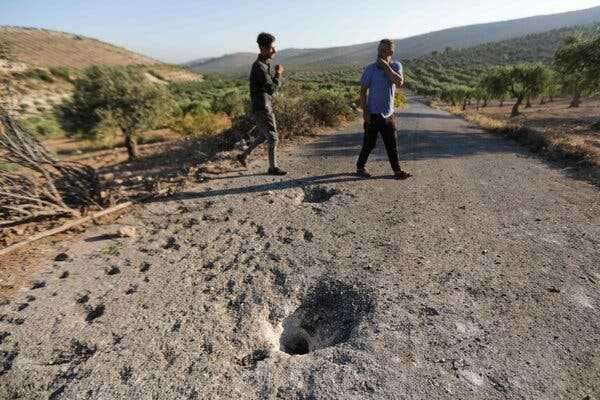The attack was the latest in a series of American operations against ISIS and Al Qaeda in Syria.
-
Send any friend a story
As a subscriber, you have “>10 gift articles to give each month. Anyone can read what you share.
Give this article
- Read in app

A crater from a drone strike in Syria on Tuesday. The attack was the latest of several American military operations against ISIS and Al Qaeda in Syria.
WASHINGTON — The U.S. military carried out a drone strike in Syria on Tuesday that officials said killed a top Islamic State commander, the third major American counterterrorism operation in the country’s northwest in the past month.
The attack killed Maher al-Agal, the leader of the terrorist group’s Syria branch and one of its top five leaders worldwide, and seriously injured another militant, according to statements from the White House and the military’s Central Command. Mr. al-Agal was responsible for “aggressively pursuing the development of ISIS networks outside of Iraq and Syria,” the military said.
“His death in Syria takes a key terrorist off the field and significantly degrades the ability of ISIS to plan, resource and conduct their operations in the region,” President Biden said in a statement.
“It sends a powerful message to all terrorists who threaten our homeland and our interests around the world,” he added. “The United States will be relentless in its efforts to bring you to justice.”
The drone strike was the latest in a series of American military operations against ISIS and Al Qaeda in Syria, which have been relatively rare since the fall of the Islamic State’s so-called caliphate in 2019.
Times Investigations of U.S. Airstrikes
Reporting by The Times has helped uncover the toll of America's air war in the Middle East and Afghanistan.
- Covering Up an Attack: A 2019 airstrike that killed dozens of women and children in Syria was buried by the military.
- A ‘Tragic’ Mistake: After a video analysis, the Pentagon admitted that a botched drone strike in Kabul, Afghanistan, killed 10 civilians.
- Patterns of Failure: A trove of hidden Pentagon records revealed systemic failures to prevent civilian deaths in U.S. airstrikes.
- Reckless Attacks: As it raced to defeat the Islamic State, a shadowy U.S. strike unit sidestepped safeguards and repeatedly killed civilians.
- Ignoring Warnings: A Syrian dam was on a U.S. “no-strike” list. In 2017, a secret American force bombed it anyway.
On June 16, Army Delta Force commandos seized Hani Ahmed al-Kurdi, a top Islamic State bomb maker and operations facilitator also known as Salim, in a ground raid in Aleppo, Syria. Nine days later, the United States carried out an airstrike in Idlib Province that the military said killed Abu Hamzah al Yemeni, a senior leader of Hurras al-Din, Al Qaeda’s branch in Syria.
The U.S. attack on Tuesday came as Mr. Biden prepared to depart for Israel and Saudi Arabia, his first visit to the Middle East as president. The trip will largely focus on Iran’s nuclear program and malign activities in the region. A White House official said on Monday that Russia was seeking hundreds of surveillance drones from Iran, including those capable of firing missiles, to use in the war in Ukraine.
There are still vivid reminders of the smoldering threat posed by Al Qaeda and ISIS, which American intelligence officials say has about 10,000 fighters who have shifted to guerrilla operations in Iraq and Syria since the collapse of the caliphate.
A risky predawn raid in northwest Syria in early February by U.S. Special Operations forces resulted in the death of the Islamic State’s overall leader, Abu Ibrahim al-Hashimi al-Qurayshi. The two-hour assault by helicopter-borne commandos came days after the end of the largest U.S. combat involvement with the Islamic State since the end of its caliphate. American forces backed a Kurdish-led militia in northeastern Syria as it fought for more than a week to oust Islamic State fighters from a prison they had occupied in the city of Hasaka.
Hundreds of people were killed in the battle, which offered stark evidence that the group’s ability to sow chaotic violence persists, counterterrorism specialists said.
The American operation in February that resulted in Mr. al-Qurayshi’s death resembled an assault in October 2019 in which Abu Bakr al-Baghdadi, the previous leader of the Islamic State, died when he detonated a suicide vest as U.S. forces raided a hide-out near where Mr. al-Qurayshi was.
“It’s clear that ISIS members are entrenched in northwestern Syria, even as their leaders continue to be apprehended and killed there,” Colin P. Clarke, a counterterrorism analyst at the Soufan Group, a security consulting firm based in New York, said on Tuesday. “It seems more likely that they have extremely limited options and that their freedom of movement has been restricted to a handful of areas where they believe they can blend in with other jihadists and large civilian populations.”
Source: nytimes.com



